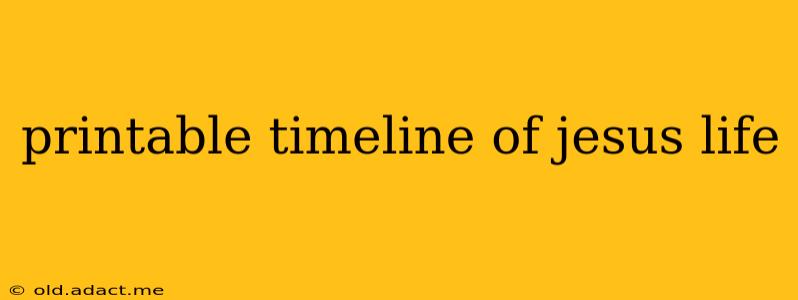Creating a printable timeline of Jesus' life can be a rewarding project for personal reflection, religious education, or classroom use. This guide will help you understand the key events and offer suggestions for creating a visually appealing and informative timeline. We'll also address some common questions surrounding the dating of these events.
What are the key events to include in a Jesus timeline?
A comprehensive timeline should cover the major events of Jesus' life, from his birth to his resurrection. Key events generally include:
- Birth of Jesus: Traditionally celebrated on December 25th, though the exact date is unknown.
- Childhood in Nazareth: This period, while less documented, is crucial for understanding Jesus' upbringing.
- Baptism by John the Baptist: Marks the beginning of Jesus' public ministry.
- Ministry in Galilee: This period includes his teachings, miracles, and the gathering of his disciples. Consider including specific miracles or parables here.
- The Sermon on the Mount: One of Jesus' most famous teachings, outlining his ethical and spiritual principles.
- Ministry in Judea: Jesus expands his ministry to Judea, encountering opposition and performing more miracles.
- Last Supper: The final meal Jesus shared with his disciples before his crucifixion.
- Arrest and Trial: Jesus' arrest, trial before various authorities, and condemnation.
- Crucifixion and Death: The events leading up to and including Jesus' crucifixion on Golgotha.
- Resurrection: The cornerstone of Christian faith, signifying Jesus' victory over death.
- Ascension: Jesus' ascension into heaven, marking the completion of his earthly ministry.
How can I accurately date the events in Jesus' life?
Dating events in Jesus' life presents challenges due to discrepancies between different accounts and the lack of precise historical records. Most scholars place Jesus' ministry between 27 and 33 AD. However, even pinpointing the year of his birth or death remains a subject of ongoing debate. It's crucial to acknowledge the limitations of dating specific events with absolute certainty when crafting your timeline.
What is the best format for a printable timeline?
The best format depends on your needs and preferences. Consider these options:
- Linear Timeline: A simple horizontal or vertical line showcasing events chronologically. This is straightforward and easy to read.
- Interactive Timeline: If creating a digital timeline, you could include hyperlinks to relevant scriptures or additional information.
- Visual Timeline: Include images or illustrations to enhance the visual appeal and make it more engaging, especially for younger audiences.
- Chart/Table Format: Organise the information in a table format, with columns for the event, date (approximate), and a brief description.
What resources can I use to create a detailed timeline?
Several resources offer detailed accounts of Jesus' life, including:
- The Gospels (Matthew, Mark, Luke, and John): The primary source for Jesus' life and ministry.
- Bible commentaries and study Bibles: These offer insights and interpretations of the biblical texts.
- Historical accounts and scholarly works: These provide context and perspectives on the historical setting of Jesus' life.
How can I make my timeline visually appealing?
- Use clear and concise language: Avoid overwhelming the viewer with too much information.
- Employ visual cues: Use different colors, fonts, or icons to highlight key events or themes.
- Choose an appropriate size: Ensure the timeline is easy to read and fits comfortably on a standard piece of paper.
- Consider adding relevant images or illustrations: Pictures can greatly enhance engagement.
By carefully selecting events, using reliable resources, and employing creative design, you can create a printable timeline of Jesus' life that is both informative and inspiring. Remember to clearly state any assumptions or limitations in your dating of events to ensure accuracy and transparency.
